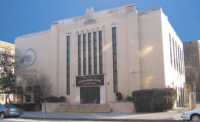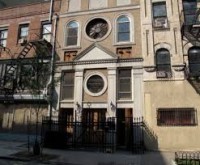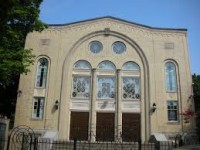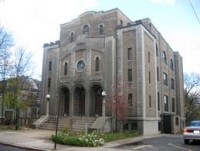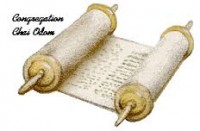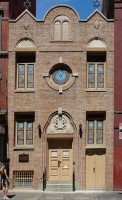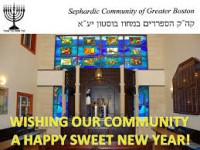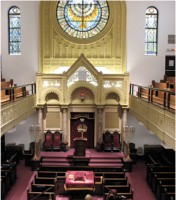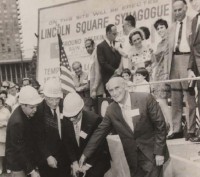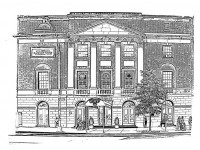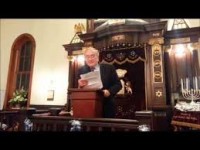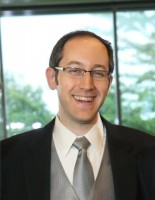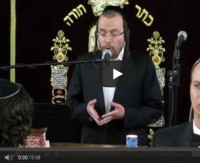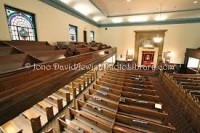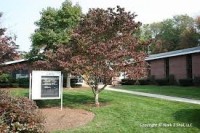The Philosophy
Chabad-Lubavitch is a philosophy, a movement, and an organization. It is considered to be the most dynamic force in Jewish life today.
Lubavitch appropriately means the “city of brotherly love”The word “Chabad” is a Hebrew acronym for the three intellectual faculties of chochmah—wisdom, binah—comprehension and da’at—knowledge. The movement’s system of Jewish religious philosophy, the deepest dimension of G‑d’s Torah, teaches understanding and recognition of the Creator, the role and purpose of creation, and the importance and unique mission of each creature. This philosophy guides a person to refine and govern his or her every act and feeling through wisdom, comprehension and knowledge.
The word “Lubavitch” is the name of the town in White Russia where the movement was based for more than a century. Appropriately, the word Lubavitch in Russian means the “city of brotherly love.” The name Lubavitch conveys the essence of the responsibility and love engendered by the Chabad philosophy toward every single Jew.
Following its inception 250 years ago, the Chabad-Lubavitch movement—a branch of Hasidism—swept through Russia and spread in surrounding countries as well. It provided scholars with answers that eluded them, and simple farmers with a love that had been denied them. Eventually the philosophy of Chabad-Lubavitch and its adherents reached almost every corner of the world and affected almost every facet of Jewish life.
No person or detail was too small or insignificant for their love and dedicationThe movement is guided by the teachings of its seven leaders (“Rebbes”), beginning with Rabbi Schneur Zalman of Liadi of righteous memory (1745–1812). These leaders expounded upon the most refined and delicate aspects of Jewish mysticism, creating a corpus of study thousands of books strong. They personified the age-old Biblical qualities of piety and leadership. And they concerned themselves not only with Chabad-Lubavitch, but with the totality of Jewish life, spiritual and physical. No person or detail was too small or insignificant for their love and dedication.
In our generation, the Lubavitcher Rebbe, Rabbi Menachem Mendel Schneerson of righteous memory (1902–1994), known simply as “the Rebbe,” guided post-holocaust Jewry to safety from the ravages of that devastation.
The origins of today’s Chabad-Lubavitch organization can be traced to the early 1940s, when the sixth Lubavitcher Rebbe, Rabbi Yosef Yitzchak Schneersohn of righteous memory (1880–1950), appointed his son-in-law and later successor, Rabbi Menachem Mendel, to head the newly founded educational and social service arms of the movement.
Today 4,000 full-time emissary families direct more than 3,300 institutions Motivated by his profound love for every Jew and spurred by his boundless optimism and self-sacrifice, the Rebbe set into motion a dazzling array of programs, services and institutions to serve every Jew.
Today 4,000 full-time emissary families apply 250-year-old principles and philosophy to direct more than 3,300 institutions dedicated to the welfare of the Jewish people
The Queens Jewish Center, also known as Queens Jewish Center and Talmud Torah or QJC, is a synagogue in Forest Hills, Queens, New York known for its significant contributions to the Jewish community. The synagogue was established by a dozen families in 1943 to serve the growing central Queens Jewish community.The current spiritual leader is Rabbi Simcha Hopkovitz.
The Queens Jewish Center building won honorable mention in the 1955 Queens Chamber of Commerce, Annual Building Awards. The architect was David Moed of Manhattan and the Builder was the LeFrak Organization.
The structure actually consists of two separate buildings. On October 3, 1946 an option was taken on the vacant plot where both Synagogue buildings now stand. Ground was first broken for the first building (also referred to as the Talmud Torah building or Bais Hamedrash building) during an elaborate ceremony on June 5, 1949, by Judge Paul Balsam and Center President Herman A. Levine. The ground-breaking for the Main Synagogue building took place on June 21, 1953 and was made possible by generous benefactor, Mr. Harry
Neighborhood
· Forest Hills was once the home of the US Open tennis tournament, played at the West Side Tennis Club before it moved to the USTA National Tennis Center in Flushing Meadows Park. When the Open was played at the tennis stadium, the tournament was commonly referred to merely as Forest Hills just as the British Open was referred to as Wimbledon.
· The neighborhood boasts a beautiful aura of old English infrastructure.
· The feeling of the neighborhood is a safe one. Conclusive for a healthy lifestyle , in mind body and spirit.
· It’s pretty picturesque scenery make it perfect surrounding for simply, better living.
· Only minutes away from the Mile long Austin street Shopping strip. As well as the large array of shopping opportunities of Queens Blvd and the boutique style antique shops of Metropolitan Ave. Truly a garden , to live in.
We’re doing something special for Purim this year, and the more of you participate, the more special it will be! Sign up for our first-everMishloach Manot Project to send your friends and fellow Stanton members traditional Purim food baskets. We prepare them for you, you sit back and enjoy Purim, proceeds go to the shul, and everybody wins!
How does it work? You should already have received an e-mail with instructions and your very own log-in code. Simply log-in to the Purim Project site and select the people you want to send to from the list of participants ($5/person or $180 for as many names as you want). The baskets will be available to be collected at the shul on Purim night,March 23, and Purim morning, March 24, when you come for megillah reading. (Please note, each participant receives one basket with a list of all the people who gave to them.)
We are honored to host the Honorable Martin Shulman this Shabbat, February 6, for a special talk in honor of Parashat Mishpatim (Laws). Judge Shulman’s talk on “Selected Torah and Secular Social Laws – No Need to Re-invent the Wheel,” will take place at 12:15pm, after kiddush, and will be followed by mincha. All are welcome!
Celebrate Shabbat with Stanton and the rest of America next week!
We will be having a community Shabbat dinner on Friday night,March 4, for the nationwide Sabbath observance known as Shabbat Across America. Click here to sign up now! The cost is $35/person or $30 for shul members. Sponsorships of $100 include dinner for two. Please let us know if you would like a vegetarian entree.
Temple Beth Shalom, also known as the Tremont Street Shul, is a warm, friendly, traditional Jewish synagogue located near the center of Cambridge, Massachusetts. We embrace a wide variety of ages, backgrounds, and styles of worship. On Shabbat evening and morning we have two styles of services. Shabbat morning services are followed by a sit down Kiddush lunch to which everyone is welcome.
HISTORY
Temple Beth Shalom was formed when Temple Ashkenaz and Congregation Beth Israel merged in 1962. The merged Shul chose to use the Temple Ashkenaz building at 8 Tremont Street because it was newer. The name was changed to Temple Beth Shalom, in part to mark a new spirit of community cooperation.
As members of the original Cambridge Jewish community migrated to the suburbs, the synagogues in Cambridge consolidated in stages. The Tremont Street Shul was the last of original Shuls to remain in operation. In the 1970’s, all the local colleges decided to have a joint Simchat Torah celebration at TBS. Helped by the success of this annual event, the Shul began to attract new members from the young professionals in the greater Cambridge area and has grown steadily since then.
Our Shul underwent a major renovation in 1987. The basement vestry was made suitable for the Alef Bet child care center, which was founded at that time. A second renovation in 1994 transformed our balcony into a convertible classroom. A new office was added in 2004. Meticulous care was taken during each renovation to conserve our building’s historic character. We think our main sanctuary is one of the Jewish architectural jewels of the greater Boston area. Come and see for yourself!
The ancestors of Temple Beth Shalom include:
Congregation Anshai Sfard, organized 1896, chartered 1898, building at 83 Webster Ave., Somerville, merged into Beth Israel 1957
Congregation Beth Israel, organized 1900, building at 238 Columbia St.
Temple Ashkenaz, split off from Beth Israel over the issue of Ashkenazic vs. Sephardic ritual 1908, building at 8 Tremont St.– originally the home of Joshua Kaplan, house torn down and a new building erected 1924
Congregation Yavneh, chartered 1918, building at 8 Howard St. erected 1920, closed 1934.
For more information on our history and the history of Jews in Cambridge, see our on-line exhibit Centennial of the Jewish Community in Cambridge, an event we celebrated in 1996.
Temple Beth Shalom is a member of the Synagogue Council of Massachusetts.
ABOUT US
Reflecting the diverse population of Cambridge, Temple Beth Shalom represents a unique, creatively traditional approach to Judaism. Our goal is to make Jews of every affiliation feel at home. Impossible? Try us.
We have three styles of worship every Shabbat and two styles of weekday services. See the worship services page for more information on the styles available. Our minyanim come together later Saturday morning for a sit-down Kiddush. Our Kiddush includes a light lunch, singing, and much fellowship. All holidays are celebrated with services and appropriate observances.
We have an active 20s and 30s group that runs several social events every month.
The Temple hosts a number of educational activities, including the Alef-Bet Child Care, a Talmud class, and other adult education programs. Along with two other local congregations we support the Kesher after-school Hebrew School program.
A unique event at Beth Shalom is our famous erev Simchat Torah celebration which draws as many as 500 or more people. Part of the fun-filled service is the Hakafot, which takes the congregation out onto Tremont St. for singing and dancing well into the night. This service attracts a wide cross-section of the Greater Boston community, including special participation of local college Hillels.
Congregation Talmud Torah Adereth El was established in 1857. It has the distinctionof being New York's oldest synagogue in its original location with continuous services. Founded four years before the Civil War, the history of Adereth El is intertwined with thatof New York City. Rabbi Sidney Kleiman OB"M served as the Rabbi of Congregation Talmud Torah Adereth El from 1939 – 1999. He continued attending services daily as Rabbi Emeritus until his passing at the age of 100 in the Spring of 2013. For more than a decade, Rabbi Gideon Shloush has infused the shul with his energy and creativity, and Adereth El is experiencing a wonderful renaissance. The Synagogue plays a vital role in New York's Jewish community. Adereth El serves the neighborhood through daily prayer services, weekly learning and outreach programs, an array of Shabbat activities, welcoming guests from around the world, providing assistance to those with loved ones in area hospitals
Adereth El's current membership reflects the diversity of its neighborhood, Murray Hill. During the work week, many Jewish businessmen with nearby offices pray at the synagogue. The congregation now includes a number of young, single members due to the growing popularity of Murray Hill with this population. Of note, many Adereth El members are students and faculty at the nearby New York University (NYU) medical center. The synagogue’s proximity to the hospital also brings in many hospital patients’ visitors as guests at Adereth El services. In fact, the synagogue typically has multiple weekly baby-naming ceremonies due to the large number of labor and delivery visitors. Additionally, due to Adereth El’s location near Yeshiva University’s Stern College for Women, many Stern students regularly attend the synagogue’s services.
The history of Congregation Adereth El is quite colorful and gives us an opportunity to look at the life and times of a Congregation as it struggles and grows in the most exciting city in the world. It is a reflection of the progress and accomplishments of New York Jews for 150 years. It is also an opportunity to look at and remember the names of men and women who have come and gone and yet whose mark lives on in the energies they gave to the Synagogue they loved.
The Text was written by Rabbi Sidney Kleiman and Andre S. Marx to be included in the 100th Anniversary Journal that was distributed at the Waldorf-Astoria Hotel on October 27, 1957. Not only did the authors undertake the massive job of reviewing the records and minutes of a century's worth of meetings, but it is obvious that they also did extensive field investigation in the community and at the records offices of New York City.
In 2013, we celebrated the 125th anniversary of the founding of the earliest of the Boston Synagogue’s predecessor shuls — Congregation Beth Jacob, founded in 1888. To celebrate this momentous occasion, the Synagogue Board formed an Archival/Historical Committee, which wrote a 260-page history book. It is the most authoritative history ever written about the synagogues of the West End. The book is available for purchase directly from the Synagogue, as well as on Amazon.com.
Much of what we have uncovered is quite fascinating and not widely known. Parts of it are funny — like the story of how some disgruntled Kosher butchers and a rejected suitor poisoned all 2,000 guests at the wedding of a rabbi’s daughter. Fortunately, no one died. We also interviewed former West End resident Leonard Nimoy, who among other things told us that the famous Vulcan salute comes from the priestly blessing that he observed as a teenager at one of our predecessor synagogue’s High Holiday services.
In some ways, the story of Boston Synagogue is the story of Boston generally: substantial growth due to immigration at the turn of the 20th century; followed by a long period of urban decline; then substantial resurgence as downtown Boston has become an increasingly attractive place for people to live. As such, we celebrate not just our synagogue, but also the entire downtown Boston community of which we are a part.
A few years ago, we established guidelines for adding artwork that complements the building’s modern design. We commissioned a new ark curtain designed by Joy Chertow, an art teacher at Solomon Schechter Day School in Newton, MA. The intricate and ornate quilting was done by Elana Schreiber, a science teacher at Schechter. The curtain was donated by Mark Schonfeld in memory of his late wife, Bobbie.
After numerous compliments about our ark curtain, we decided to commission a new wall hanging for our lobby entryway, in memory of our longstanding member Florence Wasserman. The Etz Hayim (tree of life) design with a representation of the city of Jerusalem, also designed by Joy Chertow, was chosen to represent the continuing attachment of generations of Jews worldwide to the land of Israel.
wallhangingAs part of our 125th anniversary, we created a high-resolution scan of the 1909 North Russell Street Mishna Society hand-illuminated cover page, and then created a set of enlargements from this work that now grace the sanctuary. It is a beautiful blend of the traditional and modern!
His love for his fellow man was genuine – you felt it and reciprocated in kind. Every word of Torah was precious. He would sit and think at length about any given passage. If a difficult question was posed to him, it could set off a thought process that could last hours until he responded with an answer that was breathtaking in its precision and clarity. He enjoyed people – especially young people with fresh ideas. When he reflected on his life history, you were transported back in time. You were taken to Vilna, Pinsk, Siberia, Lodz, and of course to Boston and Bnei Brak. His love for Eretz Yisrael was not based on politics or government, but was the essence of a dream to come and walk the same land tread upon by our forefathers. In fact, he was a minister without portfolio – constantly encouraging others to make Aliya. He gave respect to others, regardless of their age. In Bnei Brak, he would not move without the direction given by the illustrious Rav, Rav Yitzchak Zilberstein, Shlita.Looking back, Rebbetzin Chava Margolis a”h, was half his life. The mutual admiration was something unique to our struggling generation. It was because of this mutual respect that they were able to build and maintain and accomplish all they did.
We here in Boston were privileged to have him with us for a large part of his life. Our vibrant shul is the result of his life's work. The Mesivta of Greater Boston is named for him and his Rebbetzin, because the donor, Mr. Yitzchak Selib a”h, was befriended and educated by him. Mr. Selib also was a major donor to the Kollel, enabling them to stand on firm financial ground. For years, Rav Margolis nurtured donors for New England Hebrew Academy. He was a strong advocate for the Bais Yaakov for many years. He and his children were instrumental in the founding of Torah Academy. He founded the N'shei Agudas Yisrael which functioned successfully for many years. Agudas Yisrael of Boston, under his leadership, was the address for many great leaders of Klal Yisrael. A fruitful and productive time in Boston was followed by his move to Eretz Yisrael. It was an act of Divine Providence that he found himself in the presence of one of the great personalities of the Jewish world – Rav Yitzchak Zilberstein Shlita, son-in-law of Rav Elyashiv Ztz”l, and one of the foremost Poskim in the world. Although much younger than Rav Margolis, their mutual respect was something to behold. He referred to Rav Margolis as “Pe’er HaShchuna” the crown of the neighborhood. Rav Margolis began to give lectures in Mussar. The Sefer of the Alter of Navordok – Madreigas HaOdom – became well known in Ramat Elchonon. He acquired many friends and students – most of them many years younger than him.
Towards the end of his life he suffered a few strokes, but always displayed signs of mussar and yiras shamayim.
On the 14 of Shevat, the light of this magnificent neshama was darkened, and we are left with the memories. He was a bridge to the past, and left us with a path to the future.
To you all, I wish a happy and healthy year.
קהילה קדושה יאנינה הוא בית כנסת הנמצא ברחוב ברום (Broome) 280 בין רחובות אלן (Allen) ואלדרידג' (Eldridge) בלואר איסט סייד במנהטן ניו יורק. הוא נבנה בשנים 1925-1927 ותוכנן על ידי סידני דאוב. הוא בית הכנסת היחיד בחצי הכדור המערבי שנוהגים בו בנוסח הרומניוטים השונה גם מנוסח אשכנז וגם מנוסח ספרד.
לקהילה קדושה יאנינה יש ייחוד בהיותו בית הכנסת הרומניוטי היחיד בחצי הכדור המערבי הקהילה נוסדה ב-1906 על ידי מהגרים יהודי יוונים מיואנינה, אבל בית הכנסת לא הוקם עד 1927. השנים מאז ועד מלחמת העולם השנייה היו שנים של שפע לקהילה הרומניוטית בלואר איסט סייד. כיהנו בבית הכנסת שלושה רבנים ובימים הנוראים היה בית הכנסת מלא מפה לפה. אחרי מלחמת העולם השנייה עבר חלק גדול מבני הקהילה לרבעים אחרים וחלקים אחרים של מנהטן כולל הרלם, ברונקס וברוקלין. קהילות אלה כבר אינן פעילות היום. למרות שהקהילה התמעטה באופן קבוע מאז ימי הזוהר שלה לפני המלחמה הרי עדיין מתקיימות תפילות בבית הכנסת בשבתות ובחגים. למרות שיש לבית הכנסת רשימת תפוצה של 3,000 אנשים הרי, לעתים קרובות, חסרים אנשים למניין בתפילות השבת. סיורים מודרכים מתקיימים בכל יום ראשון למבקרים. לקהילת יאנינה יש חלקה בבית העלמין בוולווד (Wellwood). שם יש גם מצבת זיכרון ליהודי יאנינה שנספו בשואה.
הבניין נוסף לרשימה הלאומית של מקומות היסטוריים ב-30 בנובמבר 1999 וצוין כנקודת ציון של העיר ניו יורק ב-11 במאי 2004 . הוא עבר שיקום נרחב ב-2006.
Congregation Kehila Kedosha Janina
A small synagogue in New York City's Lower East Side is reaching out to make people aware of its congregation's heritage through a museum that familiarizes people with its customs and history.
The synagogue is virtually unchanged since being built in 1927 by Romaniote Jews from Janina, Greece. In 2004, it was designated a landmark by the City of New York.
Both memorabilia and the museum's tour guides describe the story of the Romaniote Jews, from their entry into Greece in the first century to their current life in America.
Differences between Greek Romaniote Jews and the Greek Sephardic Jews who fled from Spain to escape the Inquisition are featured: The two groups speak different languages and have distinct customs.
The synagogue is open for Shabbat services at 9:00 a.m. and on holidays. Look for the schedule of "Holiday Services" on our sidebar menu.
The Museum is open from 11:00 a.m. to 4:00 p.m. on Sundays, or please contact us if you wish to have a special appointment.
History
SEPHARDIC COMMUNITY OF GREATER BOSTON
The Sephardim, the first Jewish community to reach America in 1492 together with Christopher Columbus, have been living in Boston for over 350 years. They arrived around the same time as the city of Boston was incorporated in the year 1630. Spanish Portuguese Jews escaping the inquisition and persecution, settled throughout the English Colonies, regaining their freedom of religion, and building their homes and businesses. The first documented Jew in Boston was Solomon Franco, a Sephardic Jew from Holland, who arrived in 1649.
Among the famous patriots living in Boston, was Moses Michael Hays, a Portuguese Sephardi. He and his family left Newport for Boston ahead of the British attack in 1776, at a time that Boston was devastated by the physical and financial effects of the American Revolution. For the next three decades, Moses Hays and his family would play key roles in establishing the financial and cultural institutions that would define post-Revolutionary and 19th-century Boston.
He opened a shipping office in Boston and was among the first merchants there to underwrite shipbuilding, trade and insurance to newly opened Far Eastern markets. In 1784, Hays become a founder and the first depositor of the Massachusetts Bank still doing business today as part of the Bank of America. He was an honorary member of the Boston Marine Society, and a founder of the Mass Mutual Fire Insurance Company and the Mass Marine Insurance Company.
Moses Hays was also active in a variety of civic projects. He donated to subscriptions to beautifying the Boston Common, to building bridges and turnpikes, and to Harvard College.
His son, Judah Hays, and his nephews, Abraham and Judah Touro (after whom Touro Synagogue in Newport, RI, the oldest synagogue in America is named) continued in his tradition. They helped establish Mass General Hospital (Abraham Touro’s portrait is on the wall, in the main lobby), the Boston Athenaeum and the Bunker Hill Monument (The base of the Bunker Hill Monument bears an inscription honoring Judah Touro).
Besides socializing with Paul Revere and Harrison Gray Otis, these Sephardic families were sincere to their Jewish roots. Their businesses were closed on Shabbat, kosher meat was being delivered from Newport, regular prayer services were being held at their homes, and their household library contained dozens of Hebrew books.
However, with all prosperity, the early Boston Sephardic Jews were considered alien-residents. No Jewish houses of worship were allowed in Boston. Furthermore, the Hayes, Touro, Lopez and many other Boston Sephardic families had to bury their deceased in Newport, since there were no Jewish cemeteries allowed at that time. Hence, they were all tied to New York and Newport’s Spanish Portuguese congregations, where they donated regularly and were members. Not until the Massachusetts Constitutional Amendments of 1821, were the Jews granted full rights of citizenship, shortly before a group of Sephardic Algerian Jews arrived in Boston in 1830.
In 1840, the Sephardic Jews in Boston were joined by the Ashkenazim, who had just arrived from Germany, settling at first in the old South End, just South of Boston Common. German immigrants began immediately to establish the traditional institutions that characterized Jewish communities around the world, now that they were permitted in Boston. In 1842, the first Jewish congregation in Boston, calling itself Ohabei Shalom (Lovers of Peace) was formed. Their first synagogue dedicated in 1852 was strictly orthodox. It housed a Mikveh (ritual bath) and a Talmud Torah for children. Two years later, Ohabei Shalom established the first Jewish cemetery in the city. Finally, after two centuries, Boston Jews no longer had to be buried in Newport or New York City. Judah Touro included in his will a large donation to Ohabei Shalom before his death in 1854.
As Ohabei Shalom and it’s break-away, Adath Israel (today Temple Israel), eventually both became Reform Temples, the Sephardic Jews, keeping strictly to their traditional lifestyles, joined and identified with the more religious congregations, and prayed in their synagogues.
In the 1870’s through the turn of the century, there was a group of primarily North African Sephardim, who held Sephardic services in Zion’s Holy Prophets of Israel (The Alfred A. Marcus Orthodox Synagogue) in Boston’s South End. They were using a Torah Scroll dedicated by the famous Sephardic philanthropist, Sir Moses Montefiore. As the Jewish community started to migrate to the suburbs of Roxbury, Dorchester & Mattapan, so did the Sephardim. They continued praying in the synagogues on Blue Hill Ave.
Mattapan is where the history of our Sephardic Community in Brighton began. Many Sephardic Jews were fleeing Egypt, after the rise of President Gamal Abdel Nasser in 1956, who subsequently expelled all the Jews and confiscated all their property. After the transition from Egypt, usually through France, where they waited a few years to receive their visas, they arrived in the USA. Approximately sixty families settled in Boston, by the Hebrew Immigrant Aid Society.
Hacham Elie Setton, born in Aleppo, Syria, was a Torah scholar and merchant in Alexandria, Egypt. He arrived in Boston in1963, and organized the first prayer services on Yom Kippur of that year. Together with his father-in-law, R’ Eliyahu Hamaoui, and his brother-in-law, the noted Hazzan of the Great Synagogue of Cairo, Shaoul (Charles) Hamaoui and his brother-in-law, Mr. Albert Habif (later elected treasurer of SCGB), they acquired space from Rabbi Moshe Gurkow, in his newly formed Shaloh House Hebrew Day School in Mattapan, and conducted the Yom Kippur services.
That year, in attendance, there were only three families with just nine men/boys that could be counted for the minyan. They invited an Ashkenazi friend to complete the minyan. The next year, as many more families arrived in Boston, they had dozens of people at the High Holiday services. Eventually, other Sephardim living in Boston from other countries of origin, (such as the Cohen families from Greece) found their home with this Syrian-Egyptian group. Hacham Setton became the spiritual leader of the entire Sephardic community, and together with the Hazzan, Shaoul Hamaoui, they lead the services, and began a new chapter in the lives of Boston’s Sephardic Jews.
In 1965, due to the deteriorating Jewish situation in Mattapan, the Sephardic community needed to move again. Many of them settled in Brookline, around Coolidge Corner. The High Holiday Sephardic services were conducted in the Social Hall of the Southern House, on Beacon Street.
The community kept on growing in Brookline, as still many more Egyptian families were arriving, and many other local Sephardim, by now, had heard of the Sephardic services, and hundreds came to join. Eventually, the High Holiday services were moved to the Chateau Garod Wedding Hall on Beacon St. Year after year, following the High Holiday services, the community yearned that one day they should merit to have a synagogue of their own.
In 1977, under the leadership of Dr. Charles Sasson, the Sephardic Community of Greater Boston filed the legal papers, becoming incorporated as a non-profit organization in the State of Mass.
In 1979, under the leadership of Dr. Charles Naggar & Dr. Martin Hanopole, together with Rabbi Ezra Labaton & Dr. Baruch Mazor, the High Holiday services were extended to Shabbat services too, meeting every week in the Beit Midrash of Young Israel of Brookline.
In 1983, under the leadership of Mr. Clement (Rahmin) Kodsi, the community accepted our beloved Rabbi Aaron Hamaoui, who eventually succeeded his uncle and father, as Rabbi and Hazzan of the community. Rabbi Hamaoui instituted the daily minyan and many Torah classes, which continue till this day. Over the years, the Rabbi has reached out and has made a major impact on hundreds of Jewish families and international college students studying in Boston.
On Yom Kippur 1988, under the leadership of Mr. Moshe Rahmani & Mr. Edmond Shamsi, a successful campaign was launched to finally build our own synagogue. Major contributions were received from the Shamsi and Zafarani families, and also from the Cochab, Elmaleh, Feuerstein, Gabbay, Kodsi, Naggar & Sitt families. Also, among those who donated generously were the Aghion, Ariel, Bauer, Foonberg, Habif, Hassan, Lester, Mayo, Mosseri, Sabetfard, Sanieoff & Schinazi families.
In 1989, the community inaugurated their first synagogue building, Kol Sasson Bnei Shaoul, at our present location, on Corey Road in Brighton. Hence, after three and a half centuries, the Sephardim finally had their first Sephardic synagogue building in the city of Boston.
For over a quarter of a century, this synagogue building has not only served the needs of the Sephardic community, it has also homed and been instrumental in founding many other important institutions of Jewish Boston, such as the Kollel of Greater Boston, Bais Yaakov Girls High School, Ohr Yisrael Yeshiva High School, and others.
In 2008, shortly after a major renovation and completion of the Abraham Picciotto Beit Midrash, several dynamic young professionals reached out to form the New Ashkenaz Minyan (NAM). This Minyan, which is integral to the Sephardic Congregation of Greater Boston, started in October 2008 and has ever since attracting many young adults, families and students. It is a very popular destination for newcomers to Boston.
Congregation Ohab Zedek, or OZ, as it is fondly known, is more than just a synagogue. Under the leadership of Rabbi Allen Schwartz, the Shul is known for its open doors and big heart. OZ has broad ties with the surrounding Jewish community and its Upper West Side neighborhood as a whole. A random visitor could easily encounter an up and coming scholar from Israel, or members of the local fire station. It is an informal, comfortable, inclusive community.
OZ is a modern Orthodox congregation, but any individual is welcome, regardless of background or means. It is a Shul of interlocking communities–young families who find a relaxed setting on Shabbos morning to introduce their toddlers to services; singles, who famously crowd the steps on Friday night; and seniors, many of whom have been members of OZ for decades. It is home to those tentatively exploring Judaism as well as the most learned, who are stimulated by a broad array of lecturers and classes.
Rabbi Allen Schwartz became the spiritual leader of Congregation Ohab Zedek in 1988. He is an alumnus of Yeshiva College and received his Master of Arts Degree in Bible, Rabbinics and Halacha from Yeshiva University's Bernard Revel Graduate School, where he continues to work on his doctoral thesis on Rashi's methodology. Rabbi Schwartz was granted Smicha from the University's affiliated Rabbi Isaac Elchanan Theological Seminary. He currently holds the Raymond J. Greenwald Chair in Jewish Studies at Yeshiva University, where he has taught since 1983.
Rabbi Schwartz and his wife Alisa moved to the Upper West Side in 1985, where he served as rabbi at Congregation Ohav Shalom before moving to the pulpit at Ohab Zedek. Rabbi Schwartz's major focus at OZ is to foster connections within and among the many different age groups and constituencies of Jews living on the Upper West Side. Seeking to make all kinds of religious opportunities available to Ohab Zedek members, he brings information to the community regarding such subjects as Chesed, Tzedakah, Torah learning, Shatnes testing, Tefillin and Mezuzah service, and assistance with Mitzvah and Shabbos observance. Rabbi Schwartz's goal for the community is to make every OZ attendee a member of the larger community family.
Rabbi Schwartz gives weekly classes on a variety of subjects at OZ and also taught fifth through eighth grades at Manhattan Day School. He has lectured extensively for the Board of Jewish Education of New York at elementary and high schools in the New York area. Rabbi Schwartz has published curricula on Biblical themes for Jewish day schools nationally and has written Bible curricula for Yeshiva day schools and high schools. He serves on the executive board of the Rabbinical Council of America and has also served as President of the Council of Orthodox Jewish Organizations of Manhattan's West Side. Rabbi Schwartz was the camp rabbi and educational director of Camp Morasha from 1996 to 2000 and then served as the educational director of Camp Mesora from 2002 to 2005 and continues to dedicate time during the summer months to serve its educational staff.
Rabbi Schwartz recently completed a scholarly edition of the Commentary of the Rokeach to the Book of Proverbs.
Rabbi and Alisa Schwartz have six children and eleven grandchildren.
LSS is a diverse and vibrant Modern Orthodox Congregation that provides religious, social, and educational services and outreach to the unique Jewish community of the Upper West Side. The synagogue strives to be a model in the integration of Halachic Judaism and contemporary life to the broader Jewish community.
In 1964, in the living room of an apartment in Lincoln Towers, a part-time rabbi from Yeshiva University named Steven Riskin took the budding Lincoln Square Conservative Synagogue by storm. His originality, charm and boundless energy captivated members and moved them to a more traditionally observant Judaism, in turn sparking a growing Jewish renaissance on Manhattan’s Upper West Side.
Before long, a new synagogue-in-theround made its debut at 200 Amsterdam Avenue, and the excitement at the renamed Lincoln Square Synagogue brought hundreds of young single professionals to the neighborhood, creating a vibrant scene for mixing and matching. Young families were also drawn to LSS, attracted by the dazzling teachings of Rabbi Riskin, assisted by Rabbi Herschel Cohen z”l and Rabbi Ephraim Buchwald, and the gorgeous melodies of Cantor Sherwood Goffin. “The New Orthodox” they called it on the cover of New York Magazine. Who knew? But as members struggled to navigate between the laws of Jewish tradition and the secular values of the surrounding society, Lincoln Square Synagogue began to see its destiny.
Just down the street from the temples of high culture at Lincoln Center, Lincoln Square Synagogue quickly established itself as a temple of an innovative kind, showcasing the classical and the contemporary, history and modernity. With joy and pride, the challenges of present-day living were brought into harmony with the ancient traditions passed down through the generations. The sacred liturgical texts of tefillah were infused with a new vitality as haunting, time-honored melodies shared the stage with the music of Shlomo Carlebach and The Rabbi’s Sons. The thirst for wisdom was quenched with the scholarship of Rashi and Rambam blended with the insights of 20th-century thinkers like Rabbi Abraham Isaac HaCohen Kook and Rabbi Joseph Dov HaLevi Soloveitchik. Everything old was new again.
What emerged was a synagogue with its own, unique, invigorating rhythm: home to meaningful and enthusiastic worship, to be sure, but also a place to establish lifelong friendships, build businesses and organizations, find soul mates and nourish the next generation through education and religious instruction. Thousands of Jews of all ages and backgrounds had come together to create a true makom kadosh, providing support for each other in times of sorrow and sharing joy in times of simcha. LSS was now a unified community whose commitment to Judaism and love of humankind extended beyond self and family to the world at large. You could walk in off the street for the first time, as so many did, and feel you’d been here before.
As the years flew by, the stunning success of Lincoln Square Synagogue brought with it newfound responsibility: to meet the needs of an increasingly diverse membership, an ever-expanding neighborhood and a 21st-century world. New solutions for new realities were required that would acknowledge the changing landscape, while staying true to the synagogue’s core principles and personality. Recognizing the difficulties faced by those forced to care for their children and their parents at the same time, and those older members in need of help, LSS became the first local Orthodox synagogue to add a part-time social worker to its core staff, guiding those needing support and companionship through the complicated maze of social service programs.
Identifying a resurgent thirst for Torah study on an individual, one-on-one level, LSS members founded the first full-time Modern Orthodox/Religious Zionist Kollel in the New York metropolitan area, offering the learned and the uninitiated new and exciting educational opportunities that reflected a love of Torah as well as eretz yisrael and am yisrael – the land and the nation of Israel.
And always mindful of the needs of the greater Jewish community, LSS members created the Lea Segre Tomchei Shabbos Fund providing free meals to those recovering from illness and childbirth or sitting shiva, as well as the Louis Lazar Benevolent Fund providing free religious articles like siddurim, mezuzot, and tefillin to those in need. All of this and weekly Bikur Cholim visits to Roosevelt Hospital every Shabbat afternoon, annual clothing drives, and a dedicated Chesed Fund that supports a variety of charitable causes in New York and across the country. As our sages teach, “olam chesed yibaneh” – acts of kindness build the world – and Lincoln Square Synagogue always does its part.
In 2013, LSS continued the next phase of its history and moved 100 yards south to 180 Amsterdam Avenue.
Ramath Orah has a unique legacy among Upper West Side synagogues. Founded in 1941 by Rabbi Dr. Robert Serebrenik, the synagogue’s original congregation was comprised of 61 refugees from Luxembourg who escaped the Nazi occupation under extraordinary circumstances. When they arrived in New York they immediately began the work of establishing a congregation in their new home. By 1942, they had founded Congregation Ramath Orah, naming it after the community they'd left.
We want our children to love the experience of shul so that they look forward to coming every Shabbat and holiday. We want our congregants to enjoy each others’ company, linger over Kiddush, laugh with one another, and be comfortable in our shul. For our members, we want to be the first place that they think of when it is time to celebrate a simchah, and the community they turn to in times of loss.
Worship – We are a place where Jews may worship together in an atmosphere that maximizes our ability to forge a relationship with G-d. Our community embraces spiritual, melodic prayer, from a Carlebach-style Kabbalat Shabbat, to festive holiday celebrations, and daily prayer.
Learning – We are deeply committed to study and education, and there are opportunities every week to learn with our rabbis and visiting scholars.
Chesed – We are dedicated to the ideals of bikur cholim (visiting the sick) and g’milut chasadim (doing good deeds), and the Ramath Orah Team of Chesed (ROTC) can often be seen visiting sick or elderly members of the community. We seek to integrate Chesed programs into the life of our community and to involve as many of our congregants as we possibly can in our Chesed programs.
Zionism – As a Jewish community, we are strongly committed to the State of Israel and encourage advocacy and activism. We believe that the creation of the State of Israel marks the beginning of the fulfillment of G-d’s promise to the Jewish people and foreshadows our ultimate redemption. Accordingly, the preservation of the Jewish State and the ability of its citizens to live in peace, safety and prosperity is a goal of our congregation, one which we not only pray for, but contribute our time and resources to help achieve.
Engagement – All members of our community are active participants, . While everyone is welcome to attend davening in our main sanctuary on holidays, we also host a monthly women’s prayer group and weekly Children’s Shabbat programs.
We are not judgmental of our fellow Jews, and we welcome all to our synagogue and accord honors in our services without regard to affiliation or non-affiliation of our members and guests. Ramath Orah seeks to be at the forefront of mutual tolerance and respect for Klal Yisrael. Ramath Orah, moreover, does not turn away anyone, either from participation in shul activities or from receiving honors, because of an inability to pay dues or make contributions.
We aspire to be a synagogue that makes every visitor, from the moment he or she enters our Shul, feel welcome and appreciated. We want every congregant to feel a personal obligation to reach out not only to visitors and new members, but to their fellow congregants. Click here to learn more about our hospitality program.
SpatzShulPhoto tinyWe are an independent, historic Orthodox synagogue that serves a diverse congregation and the broader community.
Our little shul is a great place for davening (prayer), learning, and spiritual growth; and a social environment where we celebrate holidays and life-cycle events together.
We are a warm, caring, welcoming community where everyone can contribute and be active in the life of the congregation, build on the traditions of our founders, and link the Jewish past to the future.
The Adams Street Shul is an orthodox synagogue located near Boston, Massachusetts. The congregation was founded in 1911 — and the shul built in 1912 — by immigrants who had been settling there since the 1890's, mostly from Hungary and the Ukraine.
The synagogue is located in the Nonantum neighborhood of Newton, less than five miles from downtown Boston. Newton is famously safe, and extremely convenient to all the Boston attractions, colleges, high-tech employment, and world-class medical centers.
The Adams Street Synagogue is also convenient to mikvaot and day schools, enjoys having an eruv, and often partners with the three other orthodox synagogues within walking distance.
In the last decade of the 20th century, the antique synagogue was physically restored, and its small, vibrant congregation has been growing ever since.
The shul's members benefit from Newton's excellent municipal services. The shul's Nonantum neighborhood has more homes for rent, more two-family homes, and lower cost houses than can be found in Brookline, Sharon, or other parts of Newton. And there is an eruv.
Individuals and young families relocating to the Boston area for its job market or educational opportunities find the Adams Street Shul to be a place where they can become active and really make a difference in a welcoming, haimish community.
The synagogue is listed on the National Register of Historic Places, and the congregation has been housed there continuously for over a century.
For more information, explore the synagogue's website or contact to arrange a tour or Shabbat hospitality.
Join our diverse congregation, over one hundred years old and still going strong!
Rabbi Yosie Levine joined The Jewish Center's rabbinic team in 2004. He earned a BA in English and Comparative Literature from Columbia College and was awarded the university's William F. Curtis award for outstanding oratory. A Wexner Graduate Fellow, Rabbi Levine received rabbinic ordination from the Rabbi Isaac Elchanan Theological Seminary and was the winner of RIETS' writing prize. He holds an MPA in Public Policy from NYU's Robert F. Wagner Graduate School and is currently pursuing a doctoral degree in Modern Jewish History at Yeshiva University's Bernard Revel Graduate School. Rabbi Levine served as Rabbinic Intern, Assistant Rabbi and Associate Rabbi at The Jewish Center where he received practical rabbinic training and mentoring from Rabbi Ari Berman. Before joining the Center, he served as the educational director of the Lauder Foundation's Beit Midrash in Berlin, Germany and as the visiting scholar of Congregation Knesseth Israel in Birmingham, Alabama. Rabbi Levine has taken a leadership role on the issue of day school affordability and serves as the chair of Manhattan Day School's Political Advocacy Committee. He is co-chair of the Manhattan Eruv and is active in numerous communal organizations including AIPAC and the Beth Din of America and serves on the Board of UJA-Federation of New York. Rabbi Levine's wife, Rachel, is a clinical psychologist in private practice in Manhattan. They are the proud parents of Akiva, Yehoshua, Ari and Judy.
Rabbi Dovid Zirkind, a native of Baltimore, Maryland, joined The Jewish Center clergy in July 2012. After two years of study at Yeshivat Kerem B’Yavneh in Israel, Dovid continued his education at Yeshiva University. There he received his undergraduate degree in Psychology, graduating from the Yeshiva Program with honors. Upon graduation, Rabbi Zirkind attended the Rabbi Isaac Elchanan Theological Seminary, studying in the Marcos and Adina Katz Kollel. In 2010, Rabbi Zirkind joined the Yeshiva University Torah MiTzion Beit Midrash of Toronto, where he studied full time in the Beit Midrash and served as Rabbinic Assistant at Shaarei Shomayim Congregation. In that role, Rabbi Zirkind taught classes throughout the Greater Toronto Area, crafted programs and curricula for adults, college students and children alike and trained under a number of the communities leading Rabbis.
In his role as Assistant Rabbi of The Jewish Center, Rabbi Zirkind services the full gamut of our membership. He is the director of our Adult Education program, Jewish Center University, leads our daily minyanim and heads our Young Leadership Minyan and programming. Internally, Rabbi Zirkind teaches a number of ongoing classes and shiurim, including Talmud, Contemporary Ethics and Jewish Law. He believes that passionate Torah Study should be text based, highly engaging and grapple with the major issues of our time. In the broader community, Rabbi Zirkind increasingly represents our shul as well. He is teacher at Manhattan Day School and a frequent lecturer in local institutions including; the JCC, West Side Sefardic Synagogue, Congregation Rodeph Shalom, the RIETS Rabbinic Training Seminar and others. In addition, as a UJA Federation Grant Recipient, Rabbi Zirkind currently leads the inaugural cohort of The Jewish Center Social Action Fellowship (JCSAF). Together with his wife, Ariella, the Zirkind’s lead sought after personalized marriage workshops, which include Chattan & Kallah classes and ongoing Taharat HaMishpacha and fertility counseling for young families.
Young Israel: Past, Present and Future
"The aims and purposes of the organization shall be to foster and maintain a program of spiritual, cultural, social and communal activity towards the advancement and perpetuation of traditional Torah-true Judaism; and to instill into American Jewish youth an understanding and appreciation of the high ethical and spiritual values of Judaism and demonstrate the compatibility of the ancient faith of Israel with good Americanism.
The organization shall promote cooperation among the constituent branches now existing and which may hereafter be formed, establish a close bond of kinship to the end that their individual and common problems may more easily be solved, and act as the federated and central body for the Young Israel Movement so that its influence as a force in Jewry may be felt and recognized in America and the world over."
(from the Preamble of the National Council of Young Israel Constitution)
Young Israel was born in 1912, when the primary aspirations of most American-born Jews were economic success and acceptance in American society. Jewish education was very low on their list of priorities, and as a result, was usually rudimentary, at best. Orthodox synagogues were exclusively Yiddish-speaking and permeated by an Eastern European atmosphere. American-raised Jewish youth who wandered into these synagogues typically found themselves shut out completely. It is not surprising that the Jewish youth of that era generally avoided the synagogue, attending only when expected by family custom. Although intermarriage was relatively rare, the distance between young Jewish hearts and minds and Jewish belief and practice was almost huge. It was in this environment that Young Israel was founded by a group of 15 visionary young men and women.
Its first activities were Friday night lectures in English (which was very controversial) on a variety of topics of Jewish interest. Three years later, the group formed a "Model Synagogue" with innovations designed to attract American-raised English-speaking Jewish youth, including participatory singing and youth programs. To enable people of all means to fully participate in synagogue services, Young Israel prohibited the auctioning of synagogue honors. The National Council of Young Israel required the minimum halachic standards of a mechitza, closed parking facilities on Shabbat and Yom Tov, and that each of its synagogues officers be Shomer Shabbat. Young Israel synagogues popped up across North America.
Young Israel envisioned itself as much more than a conglomeration of synagogues. Young Israel was the first on secular college campuses, with over 20 kosher dining halls and intercollegiate programs. Young Israel created an Employment Bureau for Sabbath Observers, in an era when most employees were expected to work 6 days a week. At Young Israel’s headquarters in New York, arms were packed for the Haganah defense forces of the not-yet-born State of Israel. The Free Soviet Jewry Movement was championed by the leadership of Young Israel. Young Israel has always been fiercely Zionistic, and promoted the rights of Jews to live throughout the Land of Israel. Young Israel placed an important role in gaining broad acceptance for advocating for the commuting of Jonathan Pollard’s sentence.
Today the National Council of Young Israel provides professional advice and cost-saving initiatives to 135 Young Israel synagogues (and beyond), advocates for the interests and views of our 25,000 member families, trains aspiring rabbis, supports rabbis in the field with biweekly question and answer sessions, aides communities in rabbinic searches and relations, coordinates informative Gabbai2Gabbai conference calls, provides exciting Parsha Nation curriculum for synagogue youth groups, runs inspiring Achva Summer Teen Experiences, shares best practices through monthly e-publications Shul Solutions and The Practical Pulpit, runs a three division basketball league in the New York metropolitan area, and serves as the sponsor of four senior centers at Young Israel synagogues which feed, educate and recreate the generation that made Young Israel great.
Future plans include providing spiritual inspiration and connection for Young Professionals and training Ashkenazic rabbis how to serve their Sephardic congregants. We are committed to work to maximize the resources of the Jewish community by working with our colleagues at other Jewish organizations and Jewish institutes of higher education and to maintaining a standard of excellence in everything we do.
Shacharit Mincha/Maariv
Sunday 8:30 am
Weekday 7:00 am
Friday evening sundown
Shabbos morning 9:15 am
Montefiore Orthodox Synagogue
460 Westford Street
Lowell, MA 01851
(978) 459-9400
B"H Shalom! Montefiore Synagogue (previously known as Montefiore Society Synagogue ), the oldest synagogue in Lowell, Massachusetts was established in 1896. It relocated to Westford Street in 1971, after merging with Anshe Sfard Synagogue in 1969.
Lowell, is a great place for Orthodox Jews! We have a small close-knit Jewish community dedicated to preserving and enhancing Jewish life in the Merrimack Valley region. Lowell, Massachusetts is located off the junction of Routes 3 and 495, and is conveniently located in the high-tech region of Boston Routes 128/95 and 93. Boston is just a 45-minute drive from us and New Hampshire is just 10 minutes north of us. Lowell is home to a minor league baseball team, the Spinners , and hockey team, the Lock Monsters. Lowell has quite a number of cultural and theatrical venues, the Lowell Memorial Auditorium, the Tsongas Arena, and the Merrimack Repertory Theatre to name a few.
Rabbi Ben Skydell has been the rabbi at Congregation Orach Chaim since January 2013. He follows an illustrious tradition of major American Rabbis to have served as the Congregation’s Rabbi, including Rabbis Michael D. Shmidman, Kenneth Hain and Simon Langer.
A native of Manhattan’s Upper West Side, Rabbi Skydell is a graduate of Yeshiva College and the Rabbi Isaac Elchanan Theological Seminary. He is a long-time faculty member of the North Shore Hebrew Academy High School, and the Drisha Institute for Jewish Education, and taught for several years at Yeshivat Hadar. Rabbi Skydell also served on the rabbinic staff of Congregation Beth Sholom of Lawrence, New York for nine years.
Rabbi Skydell’s areas of interest include the intersection of Halacha and history, the spiritual worlds of mussar and hasidut, and the historical world of the Rabbis of the Talmud. Rabbi Skydell’s dynamic and engaging presentation has made him a sought-out speaker on college campuses throughout the United States.
Rabbi Skydell is married to Shani, a dedicated social worker and teacher. They are the proud parents of Hannah, Emmie and Zacky.
Cantor Yaakov Y. Stark has been described as possessing “a voice of great beauty, clear and true…breathtaking, radiant, as though from another world.” A child prodigy, at the mere age of seven Yaakov Yoseph Stark was already thrilling congregations with his heartrending solos on the High Holidays. His talent and ability were nurtured by the distinguished cantors in his family, and through continuously listening to the master cantors of the golden age: Rosenblatt, Hershman, Kwartin, Pinchik, Glantz and Koussevitzky. Huge crowds of people regularly attend to savor the stirring songs and timeless tefillos eloquently enhanced and warmly delivered by their beloved cantor. Cantor Stark was privileged to perform at numerous sold-out concerts with the most prestigious philharmonic orchestras and finest choirs throughout the world. His lyric tenor voice has put him in constant demand as a guest cantor in synagogues worldwide. Cantor Stark resides in Williamsburg, Brooklyn, with his wife and children.
Rabbi Shmidman has served the Orach Chaim congregation and Upper East Side community since 1988. In addition to Rabbinic ordination, he holds a Ph.D. degree in Public Law and Government from Columbia University. He has served as Professor and Chairman of Political and Social Science at City University of New York and most recently as Dean of Undergraduate Jewish Studies at Yeshiva University. A widely recognized scholar, he is acclaimed as an outstanding teacher and inspiring preacher. An ardent Zionist, he has been honored by religious, social and cultural institutions in Israel and the United States.
Rabbi Gavriel Bellino
A native of Lower Manhattan, Rabbi Bellino grew up attending the Young Israel of Fifth Avenue, and after graduating from Ramaz, studied at Yeshivat Shalavim outside of Yerushalayim before getting his degree in Psychology, Philosophy and Women’s Studies from Brandeis University. He pursued his smicha at RIETS before returning to his childhood community in 2006 to lead the Sixteenth Street Synagogue (formerly the Young Israel of Fifth Avenue).
With the recent joining of the Sixth and Sixteenth Street communities, Rabbi Bellino now presides as the Rabbi of the largest downtown Modern Orthodox community, ready to enter a newly invigorated era of downtown Jewish life.
During his tenure as the spiritual leader of the Sixth and Sixteenth Street communities, Rabbi Bellino has established himself as a compelling and unconventional force in Orthodox Judaism.
He has worked hard to diversify approaches and experiences to make Judaism more accessible to the entire community through programs like his Foundations of Judaism class, his Tanakh Yomi initiative, and his inspiring musical havdallah service.
Rabbi Bellino’s intellectual approach is diverse and ecumenical, integrating classical midrash, early Kabbalah and Hassidut, philosophers such as Levinas and Heidegger, underrepresented Jewish thinkers like Yeshayahu Leibowitz and Avraham ben HaRambam, all alongside traditional commentators like Maimonides and Soloveitchik. His ability to draw from such a wide net and boil down complex ideas into easily digestible points is not often seen in the Orthodox world.
Rabbi Bellino works closely with other local rabbis to maintain the downtown eruv and serves as a part of the Downtown Rabbinical Council – a newly formed committee of community leaders dedicated to the Jewish revival of Lower Manhattan.
You may be able to find him at a nearby underground coffee or beer shop, or possibly at a local boxing gym. He splits his time between Teaneck and Manhattan with his wife Cori and children Choni and Keshet.
Zmanim
Alot Hashachar 5:11a
Earliest Tallit 5:42a
Netz (Sunrise) 6:32a
Latest Shema 9:20a
Zman Tefillah 10:17a
Chatzot (Midday) 12:09p
Mincha Gedola 12:37p
Mincha Ketana 3:25p
Plag HaMincha 4:36p
Shkiah (Sunset) 5:46p
Tzeit Hakochavim 6:27p
Our Hebrew School
We create and environment that brings Judaism to life, fosters creativity and supports your child's unique style of learning. We use a unique approach which is hands-on and stimulates your child's intellect. Our curriculum has been designed to make a lasting, positive impact on the life of your child.
Judaism Comes Alive
Through drama, song art and stories we bring Judaism to life. OUr innovative methods make learning fun and memorable. We teach history by showing Jewish history, a method that encourages critical thinking. Through our mitzvah curriculum we emphasize each mivtzah's meaning for everyday life, in addition to the how-to ritual observance. Our hebrew language ensures that your child will be able to read from a Siddur (prayer book) No matter what synagogue your child affiliates with later in life, she or he will share the language of prayer with Jews around the world.
Our Staff
Our Hebrew School prides itself in our staff. Staff members are imbued with a desire to impart their love and knowledge of Judaism to their students. Recognizing that Hebrew School is an academic after-school program in addition to their regular school hours, our teachers endeavor to create an engaging program that keeps the interest of the child.
Educational Philosophy
Yeshiva Academy is founded on the principles of Chabad philosophy, which is a way of life that integrates the love of G‑d, intellectual knowledge and understanding of the Torah, and the appreciation of the uniqueness of every individual of the community.
Our administration and staff implement this philosophy in all areas of Judaic and General Studies while fostering a supportive environment for all our students.
Holistic growth in academic, spiritual, moral and social/emotions domains
Rigorous academics are pursued with a recognition that our students possess a variety of learning styles and abilities.
Students are taught to apply academic lessons from their practical settings to their daily lives.
Respect for each individual unique identity and talents forms the core of enhancing our students’ sense of self.
Ethics and moral values are explicitly taught, modeled, and practiced throughout the daily life of school.
Yeshiva teachers help our students realize that the Judaic and Secular worlds are interconnected.
Faculty strives to inspire and motivate each child to enjoy learning and a accept challenges while stimulating critical thought processes.
By empowering the head, heart, and soul, a Yeshiva education provides our students with knowledge, skills and attitudes necessary to be successful and to become members of con
The Young Israel of Sharon is a vibrant orthodox shul with a warm friendly, and relaxed atmosphere. Our ideology is inclusiveness. The Young Israel of Sharon brings together men, women, and children from a wide variety of backgrounds, with a broad array of religious styles and approaches, all unified by a commitment to authentic Torah life and spirit.
Young Israel of Sharon opened its doors in 1972 with just a minyan of families. In 2001, Young Israel moved to its present day facility. Today, we are experiencing 10% annual growth and have currently reached about 200 member families.
A variety of reasons contribute to Young Israel's growth: our family-oriented community; safe neighborhood to raise kids; modern diversity and openness; and our young and vibrant members. Another reason is Sharon’s affordable housing. Business Week online listed Sharon, MA as one of the top 20 Best Affordable suburbs in the Northeast.
Young Israel exemplifies the ideals of Modern Orthodox: serious Torah study and practice, together with an embrace of diversity and participatory openness to the best of contemporary culture and community.
Rabbi Dr. Meir Sendor is the spiritual leader of the Young Israel of Sharon, MA.
He is a recognized scholar in the field of Jewish History, specifically the history of Jewish mysticism, philosophy and medicine. He holds a rabbinic ordination from Yeshiva University, a Ph.D. with Distinction from Harvard University and a Master’s from Yale University. Rabbi Sendor lectures widely on his specialties and holds many classes on various Torah topics for all levels.


